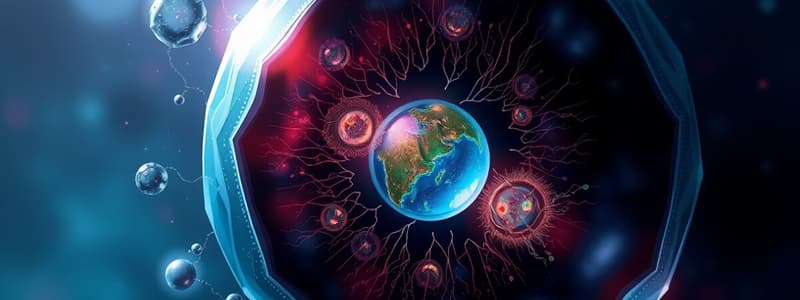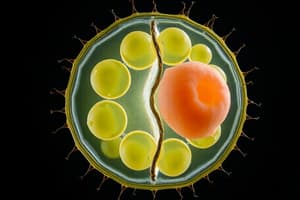Podcast
Questions and Answers
What term describes the production of offspring from a single parent without gametes?
What term describes the production of offspring from a single parent without gametes?
- Asexual reproduction (correct)
- Gene cloning
- Binary fission
- Sexual reproduction
Which stage of the cell cycle is primarily responsible for making a copy of the DNA?
Which stage of the cell cycle is primarily responsible for making a copy of the DNA?
- Gap 2
- S phase (correct)
- Gap 1
- M phase
Which of the following best describes a malignant tumor?
Which of the following best describes a malignant tumor?
- A disorganized solid mass of cells that can metastasize (correct)
- A benign growth that does not affect surrounding tissues
- An uncontrolled solid growth that is easily removed
- A solid mass of cells that remains localized
What structure holds sister chromatids together?
What structure holds sister chromatids together?
What does apoptosis refer to in cellular biology?
What does apoptosis refer to in cellular biology?
What is the main purpose of chemotherapy in cancer treatment?
What is the main purpose of chemotherapy in cancer treatment?
How many chromosomes do haploid cells contain?
How many chromosomes do haploid cells contain?
What genetic condition is characterized by the presence of an extra X chromosome?
What genetic condition is characterized by the presence of an extra X chromosome?
What process describes the failed separation of homologous chromosomes during cell division?
What process describes the failed separation of homologous chromosomes during cell division?
Which type of cell is primarily responsible for the transmission of traits to offspring?
Which type of cell is primarily responsible for the transmission of traits to offspring?
Flashcards are hidden until you start studying
Study Notes
Cell Division and Reproduction
- Cell division is synonymous with cell reproduction and is vital for growth, development, and cell replacement.
- Asexual reproduction allows offspring to be produced from a single parent, while sexual reproduction involves the fusion of two gametes, creating unique offspring.
- DNA, a double-stranded molecule, is organized into chromosomes that are tightly coiled and associated with proteins called histones.
- Each human cell contains 46 chromosomes, or 23 pairs; chromatin efficiently packages DNA, while chromatids are strands of duplicated chromosomes held together by a centromere.
Cell Cycle Stages
- Interphase consists of three phases:
- Gap 1 (normal metabolic activities),
- S phase (DNA replication),
- Gap 2 (further growth).
- M phase includes mitosis, where the nucleus divides into two genetically identical nuclei.
- Mitosis involves several phases:
- Prophase (initiation),
- Metaphase (alignment at the cell center),
- Anaphase (chromatids move to opposite poles),
- Telophase (nucleus reformation).
- Cytokinesis divides the cytoplasm and often starts during late anaphase or telophase, with cleavage furrow forming from microfilaments.
Cell Death and Cancer
- Apoptosis is programmed cell death, which occurs orderly in response to cellular signals.
- Cancer is characterized by uncontrolled and abnormal cell division, leading to the formation of tumors.
- Benign tumors are localized and clustered, while malignant tumors can metastasize, spreading throughout the body.
Oncogenes and Cancer Treatments
- Oncogenes drive the acceleration of the cell cycle, contributing to cancer development.
- Treatments for cancer include:
- Surgery (removing cancerous tissue),
- Radiation therapy (exposure to x-rays to kill cells),
- Chemotherapy (drugs targeting actively dividing cells).
Gametogenesis and Cell Types
- Sperm cells are formed from the union of two sex cells, resulting in a zygote through fertilization.
- Meiosis produces haploid cells (n) essential for sexual reproduction; in humans, the diploid number is 46.
- Spermatogenesis occurs in the testes, while oogenesis happens in the ovaries.
- Somatic cells form body tissues, while germ cells transmit genetic information to offspring.
Chromosome Organization and Abnormalities
- Homologous chromosomes comprise matched chromosome pairs with the same length and characteristics.
- Karyotyping involves arranging and viewing chromosomes; a karyogram illustrates sex chromosomes.
- X chromosome indicates female, while XY indicates male.
Meiosis and Genetic Variation
- Meiosis is fundamental for producing gametes and involves gametogenesis.
- Independent assortment during meiosis allows for random distribution of chromosomes.
- Nondisjunction, or failure to separate chromosomes, can lead to chromosomal abnormalities.
Chromosomal Abnormalities
- Trisomy refers to the presence of an extra chromosome, while monosomy indicates a missing chromosome.
- Turner syndrome results from having a single X chromosome, whereas Down syndrome is characterized by an extra chromosome 21.
- Klinefelter syndrome and Trisomy X involve additional sex chromosomes, affecting the individual's chromosomal makeup.
Studying That Suits You
Use AI to generate personalized quizzes and flashcards to suit your learning preferences.




